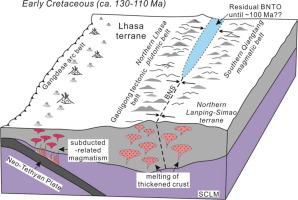当前位置:
X-MOL 学术
›
J. Asian Earth Sci.
›
论文详情
Our official English website, www.x-mol.net, welcomes your
feedback! (Note: you will need to create a separate account there.)
Petrogenesis and geodynamic implications of Early Cretaceous highly fractionated leucogranites in the northern Lanping–Simao terrane, Eastern Tibetan Plateau
Journal of Asian Earth Sciences ( IF 2.7 ) Pub Date : 2020-08-01 , DOI: 10.1016/j.jseaes.2020.104340 Zhipeng Xie , Chuandong Xue , Tiannan Yang , Kun Xiang , Di Xin
Journal of Asian Earth Sciences ( IF 2.7 ) Pub Date : 2020-08-01 , DOI: 10.1016/j.jseaes.2020.104340 Zhipeng Xie , Chuandong Xue , Tiannan Yang , Kun Xiang , Di Xin

|
Abstract A felsic intrusion in the Guaguazi Cu mining district in the northern Lanping–Simao terrane, Eastern Tibetan Plateau was revealed through drill holes and is composed of highly fractionated leucogranites. In this paper, we report zircon U–Pb ages and whole-rock compositions to constrain the petrogenesis and geodynamic setting of this intrusion. Zircon grains separated from two leucogranite samples have identical U–Pb ages of 123.9 ± 2.0 Ma and 123.6 ± 1.9 Ma, indicating that the crystallization age of the intrusion is Early Cretaceous (ca. 124 Ma). Leucogranites from the intrusion have SiO2 contents from 74.3 to 77.6 wt% with differentiation index values of 96.3–97.6, indicative of highly fractionated nature. They are weakly peraluminous (A/CNK = 1.01–1.10) and have light REE enrichment ((La/Yb)N = 5.4–8.5) and negative Eu anomalies (Eu/Eu* = 0.26–0.45). The primitive-mantle-normalized spider diagram indicates strong enrichment in large-ion lithophile elements (Rb, Th, U, K, and Pb) relative to high-field-strength elements (Nb, Ta, P, and Ti). The high initial 87Sr/86Sr ratios (0.7070–0.7094) and negative eNd(t) values (−8.18 to −7.20) and TDM2 ages of 1.58–1.51 Ga of the rocks, suggest that their source was predominantly Mesoproterozoic lower continental crust with insignificant mantle contribution. High initial 207Pb/204Pb (15.74–15.75) and 206Pb/204Pb (18.51–18.63) ratios further confirm their crustal source and highly evolved nature. Considering the petrogenetic similarity of Early Cretaceous granitoids in the Guaguazi area and the Gaoligong tectonic belt, we propose that the eastern Bangong–Nujiang Tethyan Ocean was closed at least no later than the Early Cretaceous, and that the Guaguazi granitic intrusion formed in a crustal thickening setting in response to the Lhasa–Qiangtang collision.
中文翻译:

青藏高原东部兰坪-思茅地体北部早白垩世高分异白花岗岩的成因及地球动力学意义
摘要 通过钻孔揭示了青藏高原东部兰坪-思茅地体北部瓜瓜子铜矿区的长英质侵入体,由高分异的白花岗岩组成。在本文中,我们报告了锆石 U-Pb 年龄和全岩成分,以限制该侵入体的岩石成因和地球动力学环境。从两个淡色花岗岩样品中分离出的锆石颗粒具有相同的 U-Pb 年龄为 123.9 ± 2.0 Ma 和 123.6 ± 1.9 Ma,表明侵入体的结晶年龄为早白垩世(约 124 Ma)。侵入体中的浅色花岗岩的 SiO2 含量为 74.3 至 77.6 wt%,分化指数值为 96.3-97.6,表明高度分馏性质。它们是弱过铝质 (A/CNK = 1.01–1.10) 并且具有轻的 REE 富集 ((La/Yb)N = 5.4–8。5) 和负 Eu 异常 (Eu/Eu* = 0.26–0.45)。原始地幔归一化蜘蛛图表明大离子亲石元素(Rb、Th、U、K 和 Pb)相对于高场强元素(Nb、Ta、P 和 Ti)的富集。岩石的高初始 87Sr/86Sr 比值 (0.7070–0.7094) 和负 eNd(t) 值 (-8.18 到 -7.20) 和 TDM2 年龄为 1.58–1.51 Ga,表明它们的来源主要是中元古代下陆壳,不重要地幔贡献。较高的初始 207Pb/204Pb (15.74–15.75) 和 206Pb/204Pb (18.51–18.63) 比率进一步证实了它们的地壳来源和高度演化的性质。考虑到瓜瓜子地区与高黎贡构造带早白垩世花岗岩的成因相似,
更新日期:2020-08-01
中文翻译:

青藏高原东部兰坪-思茅地体北部早白垩世高分异白花岗岩的成因及地球动力学意义
摘要 通过钻孔揭示了青藏高原东部兰坪-思茅地体北部瓜瓜子铜矿区的长英质侵入体,由高分异的白花岗岩组成。在本文中,我们报告了锆石 U-Pb 年龄和全岩成分,以限制该侵入体的岩石成因和地球动力学环境。从两个淡色花岗岩样品中分离出的锆石颗粒具有相同的 U-Pb 年龄为 123.9 ± 2.0 Ma 和 123.6 ± 1.9 Ma,表明侵入体的结晶年龄为早白垩世(约 124 Ma)。侵入体中的浅色花岗岩的 SiO2 含量为 74.3 至 77.6 wt%,分化指数值为 96.3-97.6,表明高度分馏性质。它们是弱过铝质 (A/CNK = 1.01–1.10) 并且具有轻的 REE 富集 ((La/Yb)N = 5.4–8。5) 和负 Eu 异常 (Eu/Eu* = 0.26–0.45)。原始地幔归一化蜘蛛图表明大离子亲石元素(Rb、Th、U、K 和 Pb)相对于高场强元素(Nb、Ta、P 和 Ti)的富集。岩石的高初始 87Sr/86Sr 比值 (0.7070–0.7094) 和负 eNd(t) 值 (-8.18 到 -7.20) 和 TDM2 年龄为 1.58–1.51 Ga,表明它们的来源主要是中元古代下陆壳,不重要地幔贡献。较高的初始 207Pb/204Pb (15.74–15.75) 和 206Pb/204Pb (18.51–18.63) 比率进一步证实了它们的地壳来源和高度演化的性质。考虑到瓜瓜子地区与高黎贡构造带早白垩世花岗岩的成因相似,











































 京公网安备 11010802027423号
京公网安备 11010802027423号